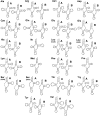Physella acuta: atypical mitochondrial gene order among panpulmonates (Gastropoda)
- PMID: 25368439
- PMCID: PMC4214460
- DOI: 10.1093/mollus/eyu025
Physella acuta: atypical mitochondrial gene order among panpulmonates (Gastropoda)
Abstract
Mitochondrial (mt) sequences are frequently used for phylogenetic reconstruction and for identification of species of molluscs. This study expands the phylogenetic range of Hygrophila (Panpulmonata) for which such sequence data are available by characterizing the full mt genome of the invasive freshwater snail Physella acuta (Physidae). The mt genome sequences of two P. acuta isolates from Stubblefield Lake, New Mexico, USA, differed in length (14,490 vs 14,314 bp) and showed 11.49% sequence divergence, whereas ITS1 and ITS2 sequences from the nuclear genome differed by 1.75%. The mt gene order of P. acuta (cox1, P, nad6, nad5, nad1, D, F, cox2, Y, W, nad4L, C, Q, atp6, R, E, rrnS, M, T, cox3, I, nad2, K, V, rrnL, L1, A, cytb, G, H, L2, atp8, N, nad2, S1, S2, nad4) differs considerably from the relatively conserved gene order within Panpulmonata. Phylogenetic trees show that the 13 protein-encoding mt gene sequences (equivalent codons) of P. acuta group according to gastropod phylogeny, yet branch lengths and dN/dS ratios for P. acuta indicate elevated amino acid substitutions relative to other gastropods. This study indicates that mt sequences of P. acuta are phylogenetically informative despite a considerable intraspecific divergence and the atypical gene order in its mt genome.
Figures






Similar articles
-
Comparative immunological study of the snail Physella acuta (Hygrophila, Pulmonata) reveals shared and unique aspects of gastropod immunobiology.Mol Immunol. 2018 Sep;101:108-119. doi: 10.1016/j.molimm.2018.05.029. Epub 2018 Jun 17. Mol Immunol. 2018. PMID: 29920433
-
Integrative taxonomy unveils a new species of Dugesia (Platyhelminthes, Tricladida, Dugesiidae) from the southern portion of the Taihang Mountains in northern China, with the description of its complete mitogenome and an exploratory analysis of mitochondrial gene order as a taxonomic character.Integr Zool. 2022 Nov;17(6):1193-1214. doi: 10.1111/1749-4877.12605. Epub 2021 Dec 15. Integr Zool. 2022. PMID: 34783153
-
Characterization of the complete mitochondrial genome of Tryporyza incertulas, in comparison with seven other Pyraloidea moths.Gene. 2014 Jan 1;533(1):356-65. doi: 10.1016/j.gene.2013.07.072. Epub 2013 Aug 15. Gene. 2014. PMID: 23954873
-
A complete mitochondrial genome from Echinochasmus japonicus supports the elevation of Echinochasminae Odhner, 1910 to family rank (Trematoda: Platyhelminthes).Infect Genet Evol. 2016 Nov;45:369-377. doi: 10.1016/j.meegid.2016.09.024. Epub 2016 Oct 1. Infect Genet Evol. 2016. PMID: 27702649
-
The mitochondrial genome of Priapulus caudatus Lamarck (Priapulida: Priapulidae).Gene. 2007 Mar 1;389(1):96-105. doi: 10.1016/j.gene.2006.10.005. Epub 2006 Oct 20. Gene. 2007. PMID: 17123748
Cited by
-
The complete mitochondrial genome of the file ramshorn snail Planorbella pilsbryi (Mollusca: Gastropoda: Hygrophila: Planorbidae).Mitochondrial DNA B Resour. 2021 Oct 11;6(11):3181-3183. doi: 10.1080/23802359.2021.1975508. eCollection 2021. Mitochondrial DNA B Resour. 2021. PMID: 34746397 Free PMC article.
-
The complete mitogenome of Orcula dolium (Draparnaud, 1801); ultra-deep sequencing from a single long-range PCR using the Ion-Torrent PGM.Hereditas. 2017 Apr 4;154:7. doi: 10.1186/s41065-017-0028-2. eCollection 2017. Hereditas. 2017. PMID: 28396619 Free PMC article.
-
The complete mitochondrial genome of the widespread freshwater limpet Ferrissia californica.Mitochondrial DNA B Resour. 2025 Apr 15;10(5):382-386. doi: 10.1080/23802359.2025.2487068. eCollection 2025. Mitochondrial DNA B Resour. 2025. PMID: 40241799 Free PMC article.
-
Diversity of echinostomes (Digenea: Echinostomatidae) in their snail hosts at high latitudes.Parasite. 2021;28:59. doi: 10.1051/parasite/2021054. Epub 2021 Jul 28. Parasite. 2021. PMID: 34319230 Free PMC article.
-
The mitochondrial genome of the planorbid snail Planorbella duryi.Mitochondrial DNA B Resour. 2018 Oct 30;3(2):972-973. doi: 10.1080/23802359.2018.1503939. Mitochondrial DNA B Resour. 2018. PMID: 33474384 Free PMC article.
References
-
- ALBRECHT C., KROLL O., MORENO-TERRAZAS E., WIEKE T. Invasion of ancient Lake Titicaca by globally invasive Physa acuta (Gastropoda: Pulmonata: Hygrophila) Biological Invasions. 2009;11:1821–1826.
-
- ARMBRUSTER G.F.J., BERNHARD D. Taxonomic significance of ribosomal ITS-1 sequence markers in self-fertilizing land snails of Cochlicopa (Stylommatophora, Cochilcopidae) Mitteilungen aus dem Museum für Naturkunde in Berlin, Zoologische Reihe. 2000;76:11–18.
-
- ARMBRUSTER G.F.J., KORTE A. Genomic nucleotide variation in the ITS1 rDNA spacer of land snails. Journal of Molluscan Studies. 2006;72:211–213.
-
- BALLARD J.W.O., WHITLOCK M.C. The incomplete natural history of mitochondria. Molecular Ecology. 2004;13:729–744. - PubMed
Grants and funding
LinkOut - more resources
Full Text Sources
Other Literature Sources
Research Materials
